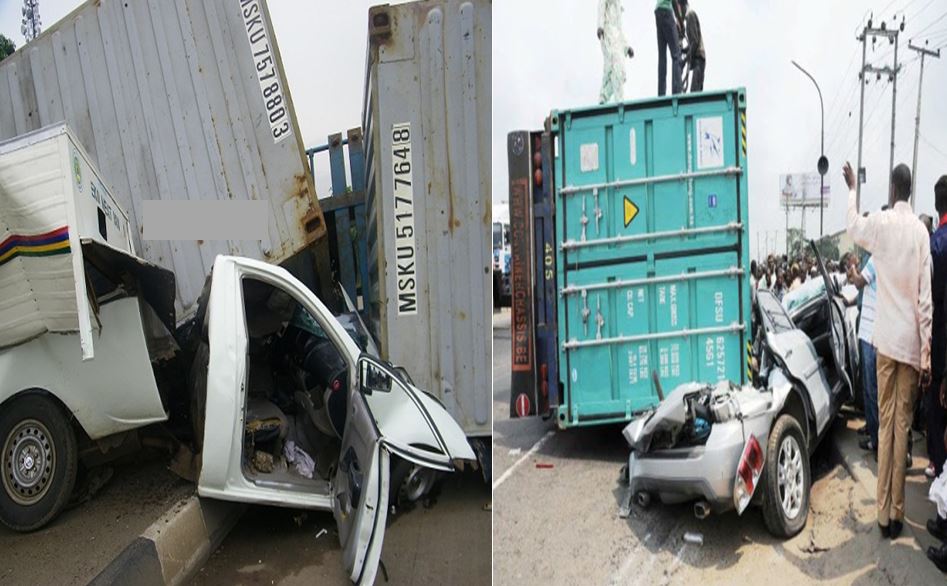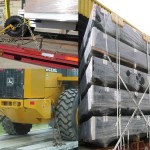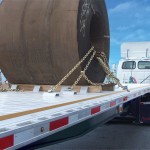

INTRODUCTION
In early February 2011, a truck conveying a 14-foot container fell and killed a man at the junction of the New Garage bus stop along Ikorodu Road in Lagos.
On the 21st of November 2012, no fewer than three persons were crushed to death when a 40-feet containerized vehicle fell on a Mazda car along Badagry-Seme Expressway.
On the 26th of June, 2012, a female pedestrian was crushed to death in the morning at Berger area of the Lagos-Ibadan Expressway by a container after it fell from a moving trailer.
Sometime in May 2013, a 20.5 tons steel roll fell off a truck at the descent of Sango-Ota Bridge towards Ifo. It left four cars badly crushed and took about 2days to safely remove from the point where it created a crater on the road. The traffic gridlock on that axis for that period was horrific!
On the 6th of June, 2013, two persons lost their lives when two containers fell off a truck and landed on an Eko Meat van on the busy Agege Motor Road. Whatever caused the accident was immaterial. The general sentiment was that the damage would have been minimal if the containers were properly latched to the bed of the truck conveying them.
These are very few in the depressingly high number of fatalities that have been traced to improperly latched or restrained cargoes falling off trucks. In fact, a conservative estimate have it that an average of 20 containers fall off trucks on a monthly basis in Lagos with more of the incident occurring around the Apapa-Tin Can corridor.
Recently, while reacting to the incidence of container crashes, the Chairman, Association of Maritime Truck Owners (AMATO), Chief Remi Ogungbemi attributed the incessant falling-off of loaded containers from trucks to overloading and the poor state of the roads. He went further to state that:
A lot of the containers are falling off trucks because there are no regulations. Some trucks are not supposed to carry more than 10 tons, but you see some of such trucks carrying 20 or 30 tons. Such containers will definitely fall-off, but it is not the fault of the truck owner because there are no weighbridges to weigh the containers. The truck customers also contribute to the problem because they want to cut corners. They present papers to show it is a light load, but by the time the truck is loaded, you will discover it is different from what they claimed
Good point no doubt! But this opinion tells only half the story. A rationalization that pushes the responsibility for a malaise to everyone and anyone aside the person or body making it could easily be written-off as self-serving.
Studies from around the world have indeed averred that cargo falling-off trucks has more to do with breaches in securement/containment procedure than with the state of the road or unethical antics of some freight owners.
FACTS ABOUT CARGO SECUREMENT
Most drivers and motor carriers ought to know that properly securing their cargo is one of the most important steps they need to take before heading out on the highway. Losing your load or allowing something to fall into the path of another vehicle can have disastrous consequences for everyone involved.
If you are driving a vehicle that is carrying a load or towing a trailer that is carrying a load, the obligation is on the driver/carrier to make sure that the load is restrained properly. Load restraint or cargo securement is not just about making sure that the load does not come off —it is also about making sure that the load does not shift in a way that makes the vehicle unsafe to handle or allows the load to crash into the driver’s cabin, which may cause injury or death.
If you don’t restrain a load properly you might cause an accident, injury or death if:
- Objects fall from your vehicle on to other traffic or pedestrians
- Other drivers swerve to dodge items that are falling or have fallen from your vehicle
- Loads that have spilled onto the road cause other vehicles to skid and lose control
- Uncovered loads crash into your vehicle cabin during emergency braking
- Loads that aren’t restrained properly shift and contribute to your car rolling over.
The fundamental load restraint requirements require that any load carried on or in a vehicle or trailer must:
- Not be placed in a way that makes your vehicle unstable or unsafe notwithstanding the condition of the terrain you are on. And that is simply because the terrain ought to have been factored into the loading and trip planning process.
- Be secured so it won’t move or fall from your vehicle while driving—including driving consisting of emergency braking or turning suddenly
- Not project from your vehicle in a way that is likely to injure a person, obstruct the path of other drivers or pedestrians, or damage another vehicle or anything else
- Be restrained using an appropriate securement system and method (we will discuss this in detail shortly).
Also, loads must not cover number plates, lights and reflectors. If a load projects more than 1.2 metres behind a motor vehicle or a trailer OR if the load projects in a way such that it would not be readily visible to a person following immediately behind a vehicle or trailer, a brightly coloured red, red and yellow, or yellow flag (measuring at least 450mm by 450mm) must be fixed to the extreme back of the load. Also, at night, a red light or at least two red reflectors must be fixed to the extreme back of such a load.






